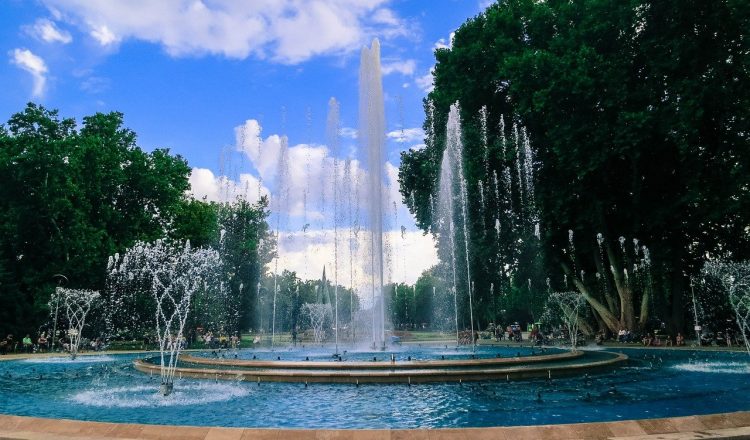
One island, nine names

Margaret Island is likely the most often renamed site of Hungary. It had number of different names over the ages, including: Isle of Lords, Isle of Rabbits (in latin: Insula Leporum), Saint Andrew’s Island, Island of Our Lady, Maiden Island, Kvsadasi (its Turkish name), Isle of Buda, and Palatinus Island. The many changes are even more bizarre given the fact that the area is the youngest part of Budapest in terms of geology and geography. Its original size covered the area of 58 hectares, and had been developed by the alluvial silts of River Danube running through the city. Back then the island comprised 3-4 different islets. It has been formed into a single island, as seen today, by flow regulation. Inscribed stones and coin finds from the 2nd – 4th century have been discovered during archaeological excavations on the island, while the earliest written mention of the place dates back to 1225. King Imre moved his court on the island at the turn of the 12th-13th century. The 1245 Charter of King Béla IV reveals that the king’s ancestors handed over the island to the Premonstratensians. There were times when even a small village, namely St. Paul’s village (Szent Pál falva) was located in the area. The Cardinal of Esztergom as well as the Johannites also had a castle on the Island.
Storm on the Island
Following the Mongol invasion King Béla IV was forced to flee the country in 1241, settling temporarily in the vicinity of Split. Here was born his daughter Margaret, known as Saint Margaret of the Árpád Dynasty. Shortly after the King’s return to Hungary, he sent his daughter to a convent in Veszprém (Hungary). In 1252 Princess Margaret and her 17 fellow nuns moved the convent to the then called Island of Rabbits, where she lived until her death in 1270. Her tomb became a shrine, and remained so for about a quarter of a century. During the Ottoman rule the nuns left the convent and took with them Blessed Margaret’s remains, which had been lost following the Habsburg ruler, Emperor Joseph II’s regulation in 1782 on dissolving the monastic orders. Margaret of the Árpád Dynasty was canonised in 1943. A devastating storm struck the island in 1914, trees were uprooted, surprisingly revealing the still-intact bell of the nun’s cloister. Excavations were carried out between the two world wars, though some parts of the cloister ruins have remained unearthed. The currently visible sections include the western court, chapel, queen’s residence, tower, sacristy, church, cloister, chapter hall, kitchen, furnace room, dining hall, well-house, laymen’s dining room and the study.
The birth of Margaret Island
In 1790 gigantic reconstruction works began on the island, after it had been gifted to Archduke Alexander Leopold of Austria by the Parliament. Alexander, as the Palatine of Hungary envisioned and initiated a design on the model of the Schönbrunn gardens. After his death the works had been continued by his younger brother, Archduke Joseph of Austria, also bearing the title of the Palatine of Hungary, who paid special attention to the development of the island. The Chief Gardener, Károly Tost became his partner to materialise and carry out the grandiose plans. Palatine Joseph set up a holiday home on the island for his wife, the Grand Duchess Anna Pavlovna. Following the 1848-49 Revolution and War of Independence flow control works were started close to the island. The river bed was cleared, sands of one of the small isles dredged, while the lower isle was earthed up and linked to Margaret Island. It could have been approached by boat only until 1901, when an additional side-bridge was built to connect the island to Margaret Bridge, the inauguration of which had taken place in 1876. The island’s northern edge was connected to the Árpád Bridge only 1950.
There was a time when all the rose species of the world were blooming here
In the times of the Austro-Hungarian Monarchy pine tree rarities were planted on the island, and a horse-drawn carriage took the passengers around the magnificent gardens until 1928. The island was in the private ownership of the Palatine’s son, Archduke Joseph Karl of Austria till 1905. He purchased the Painter Island from the city of Buda, and annexed it to Margaret Island. The Hungarian state acquired the island in 1908, then by involving German and French capital, a company was founded to build a thermal bath on it. In the 1880’s an attractive Japanese garden was created along with a Pheasant Preserve, an Artists’ Promenade and a Rose Garden with 16 thousands of blooming rose bushes. As from 1870 the territory had been earthed up to protect the area from the seasonal floods. Immense gardening developments took place: 60 cubic meters of soil was moved, 50 acres of land were grassed, a 6 kilometres long walkway was built, more than 3000 trees and 50 thousand of shrubs were planted. The Rose Garden had 25,000 of plants, with all the rose species known at the time. Margaret Island has always been an attractive site, holding its popularity to this day. It is also the home of the first horticulture relics, namely the Dominican convent garden, being also famous for its water supply system already existing in 1251. From 1929 the island was classified as a health resort. The ruined trunks of trees preserve the sad mementos of World War II.
All the luxury of a miniature city in one place
The Franciscans arrived in the city in the 13th century, their convent had been ruined by the Ottoman Empire. Palatine Joseph’s villa was built right next to the ruins. The oldest building on the island may have been the chapel of the Premonstratensians. Archaeological excavations in the 12th century building unearthed the walls of a Chapel from the 11th century. The Grand Hotel, being the best known building of the island, is the masterpiece of a Hungarian architect, Miklós Ybl. He also constructed a thermal bath, which has been demolished after the 1956 flood. In order to ensure the smooth water supply of the island a Water Tower was built in 1911. The Palatinus Bath and swimming pool was constructed between the two world wars. The swimming pool is the work of architect Alfréd Hajós, the first Hungarian Olympic swimming champion, and was opened in 1930. The Island’s open air theatre with a capacity of 3000 seats was built in 1938. The outstanding Musical Fountain was set up two years earlier, designed by architect Péter Kaffka upon the original pattern of a Transylvanian fountain.
One of the most favoured spots of Budapest will play an important role during the week of the 52nd International Eucharistic Congress, the island will serve as the venue for the Festival of Families on the 11th September.
Photo: pixabay










